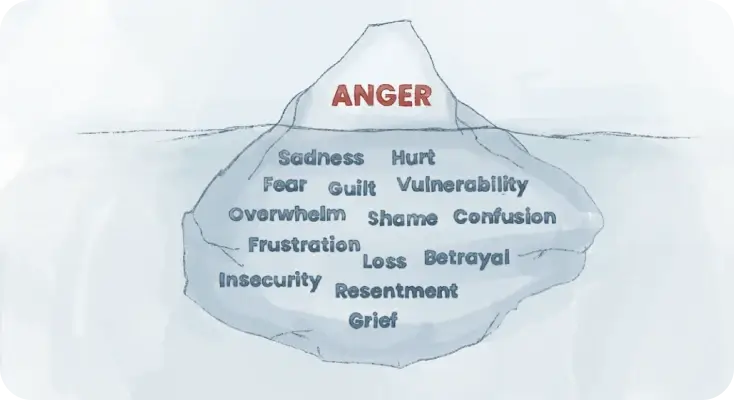ANGER. These 5 letters hold so many hidden stories — more than meets the eye.
But anger might be a secondary emotion. There’s something much deeper lying beneath the surface. Something that you’re trying to hide or ignore to avoid facing vulnerability.
Let’s unpack this iceberg of anger and find out how it works and how it helps you experience emotions.
What is anger iceberg?
This is an illustrative depiction of anger like an actual iceberg. The term, created by the Gottman Institute, suggests a more comprehensive approach to understanding anger.
Irritability often acts as a visible “tip” of the anger iceberg. Still, there’s much more hidden beneath the surface than noticeable immediately. [1]
Other emotions can lie “underwater,” driving the reaction. As such, anger often masks an emotional baggage that we might not even be fully aware of.
For example, your partner has forgotten to congratulate you on a relationship anniversary. Your first reaction may be anger — sharp words or even silence. But beneath that anger might be sadness, or fear of being unimportant to them.
In fact, this happens quite often. Thus, Gottman’s anger iceberg can help us recognize our real feelings.
Do you want to understand your feelings better and improve emotional intelligence (EQ)? Try this simple test to identify what triggers your responses and how to take control of them.
On the top of the anger iceberg
When people are angry for no reason, they usually notice the top of the anger iceberg. While some reactions might be different for everyone, some patterns are common.
- Physical tension. When angry, your body tenses up. This could manifest as tightness in the shoulders, jaw clenching, or a stiff neck.
- Irritability or impatience. Anger can make you more sensitive to even small annoyances, leading to impatience when things don’t go as expected.
- Raised voice. When a person gets irritated, it’s common to speak louder and show the tip of the anger iceberg, often without realizing it. This can be a sign that emotions are taking control of the conversation.
- Difficulty concentrating. Anger can cloud your thoughts, making it harder to focus on tasks or listen to others because your mind is preoccupied with the emotional intensity.
- Red face or sweating. Physical signs from the top of the anger iceberg often include a flushed face, sweating, or tensed muscles.
- Verbal aggression (passive-aggressive comments). When you don’t want to express anger directly, it can come out as sarcasm.
Under the surface of the iceberg of anger
When asking, “Why am I so irritable with my partner, friends, or family?” it might be helpful to think broader. Many emotions can cause intense irritability.
Here are the most common ones that may become the core of an anger iceberg activity.
- Sadness. Anger can be a defense mechanism against vulnerability.
- Fear. We might react with anger when we’re afraid of being judged or out of control.
- Embarrassment. The secondary emotion of the anger iceberg may be the worries about how others perceive us.
- Guilt. We may use anger when we haven’t resolved feelings of regret or shame about our actions.
- Disappointment. To react somehow instead of feeling let down, people can turn to anger.
“From your experience, how can we identify which underlying emotion causes anger right at the moment? If multiple emotions are involved, how can we spot them? Enna Sanghvi, MA, answers, “Introspection is key. To identify the emotion behind anger, pause and ask yourself, “What am I really feeling right now?” Pay attention to your body — tightness might mean sadness, heat could signal frustration, and a sinking feeling might point to fear. If multiple emotions are involved, focus on what feels strongest at the moment, then explore others later. It’s about slowing down and listening to yourself.”
Anger iceberg PDF
Next time you suddenly feel irritable, you can turn to this simple yet effective anger iceberg worksheet. Download it now and use it anytime you need a fresh perspective on your emotions.

How the anger iceberg worksheet might be helpful
“Anger signifies that something is wrong. That something needs to be fixed. Something needs to be protected. It can also signify that something really important and meaningful is happening right now.” — Jacob Ham, PhD
Irritation and anger don’t come from nowhere. And if you learn to spot why you feel angry, this can give you greater control over your emotions and help you choose your responses.
- Notice similar patterns. When turning to the anger iceberg image and PDF worksheet regularly, you can track that some emotions and reactions tend to resurface in certain situations. This opens up opportunities for a deeper understanding of why this happens.
- Find out what feelings you try to bottle. Rod Mitchell, R. Psych. from Emotions Therapy Calgary states, “You might think you’re keeping the peace by not expressing your emotions, but this can lead to unexpected outbursts later.” [2] The anger iceberg theory may help you identify and process those bottled-up feelings before they erupt.
Enna Sanghvi, MA, adds, “Once you notice the emotions underlying your anger, the next step is to address them directly. Practice expressing those feelings calmly, like saying, “I feel hurt because…” instead of reacting with anger. Write it on a piece of paper and tear it up, or try journaling, or try talking out loud.”
Sources
- University of Rochester Medical Center. “Anger Expression.” August 2022
- Emotions Therapy Calgary. “The Hidden Causes of Anger Issues (and How to Overcome Them).” September 2024
Disclaimer
This article is for general informative and self-discovery purposes only. It should not replace expert guidance from professionals.
Any action you take in response to the information in this article, whether directly or indirectly, is solely your responsibility and is done at your own risk. Breeze content team and its mental health experts disclaim any liability, loss, or risk, personal, professional, or otherwise, which may result from the use and/or application of any content.
Always consult your doctor or other certified health practitioner with any medical questions or concerns
Breeze articles exclusively cite trusted sources, such as academic research institutions and medical associations, including research and studies from PubMed, ResearchGate, or similar databases. Examine our subject-matter editors and editorial process to see how we verify facts and maintain the accuracy, reliability, and trustworthiness of our material.
Was this article helpful?






